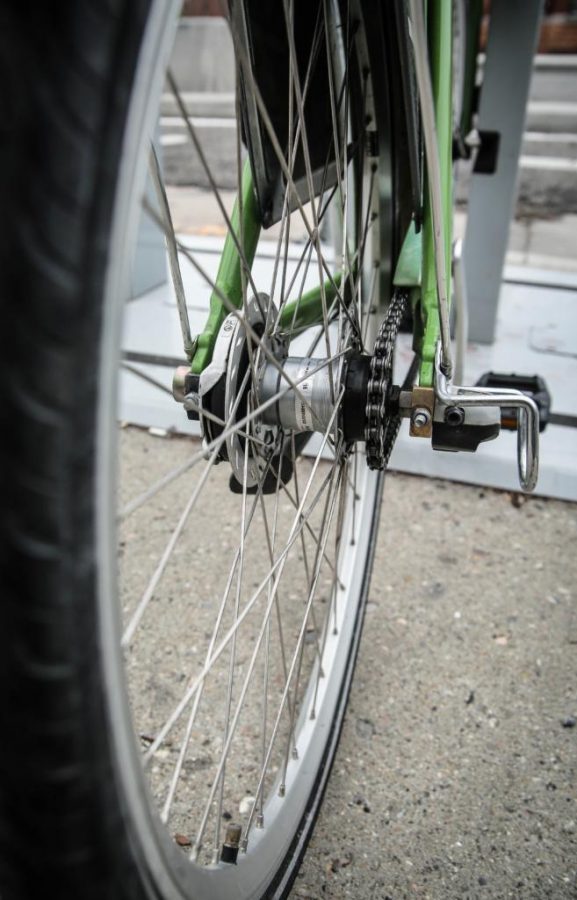Scott: Clean the Air by Switching to Your Bike
Electric bikes in downtown Salt Lake City on Thursday, April 5, 2018.
September 5, 2019
The University of Utah is absolutely beautiful this time of year. Sharp architectural silhouettes, clusters of trees and bright lawns frame its picturesque open spaces, providing students a relieving glimpse of mountains and cityscape between classes. Unfortunately, these scenic views are not guaranteed year-round, especially as the inevitable inversions of Utah’s colder seasons begin to approach. In just a few months, the U’s outlook over a sparkling Salt Lake City will dim beneath the dusky fumes of pollution.
While the steady accumulation of smog across the Wasatch Front is visible to everyone, U students hold front-row seats to the gloom. This toxic haze should generate concern, discussion and even irritation among students. Instead of allowing its vastness to overwhelm them, the students of this commuter campus should turn their apathy into action.
Whether they turn off their idling vehicles, utilize the university provided UTA pass or ask their state legislators to support clean air legislation, students have options for improving their environment. Because a large chunk of the inversion-causing emissions across the Wasatch Front is created by personal vehicle use, students can make a difference by adjusting their own driving habits. While students can cut their fuming contributions back by driving smarter, it would be better if they avoided using their cars as often as possible.
Younger generations may be conscious consumers, but their spending ability is shrinking. Biking to campus is a great option for commuters who are serious about improving Utah’s environment despite their limited means. The switch from car to bike may seem intimidating and inconvenient, but for the right student, it has a surprisingly high return on investment. While biking provides the obvious benefits of physical exercise and exposure to the outdoors, it can be just as fast as driving to and parking on campus — even for students who commute from the suburbs.
Bikes are quiet, nimble and far less obtrusive than cars. Driving might be familiar, comfortable and climate-controlled, but it often lengthens commuting time as drivers search out larger faster roads. Not only can biking be more direct, it necessitates greater awareness of one’s surroundings, allowing bikers to anticipate time-consuming obstacles and reroute. Bikers can quickly evade traffic and construction that brings cars to a standstill. Biking along a safe, efficient route during the warmer months of the year is a perfectly reasonable alternative to driving to campus.
Biking involves exposure to the elements and inconvenient sweating, but driving to the U has plenty of limitations of its own. Personal vehicles are assumed to be the optimal mode of transportation, but in many cities, driving has been shown to be slower than walking. Most Salt Lake streets experience high traffic during commuting hours, with congestion only worsening the closer one gets to campus. Traffic stands still within the neighborhoods surrounding the U, undercutting any time saved by hopping on the freeway or taking a back road.
This is without factoring in the bane of a commuter’s existence – finding a parking spot. Student parking at the U is already controversial. The university has designated nearly 20,000-30,000 parking spots (depending on which areas of campus are counted) for the use of roughly 48,700 students. Vehicle permits are already expensive and stakeholders are constantly lobbying for more or less parking availability – and students are often disgruntled with the results. When parking can be found, it is rarely close to the classroom, which may take a 10- to 15-minute walk to reach. No matter how timely the commute to campus, parking is always a time-wasting obstacle.
Biking is a surprisingly practical mode of transportation for students who wish to improve their environment without completely disrupting their busy lifestyle. Biking is an adjustment that may not work for parents of young children or students who live far from campus, but many students would be surprised at how quickly a 10-mile bike ride flies by. Students should not feel discouraged by the effort and sacrifice of biking to campus, and should instead leap at this sustainable opportunity to combat the air pollution they see around them.








